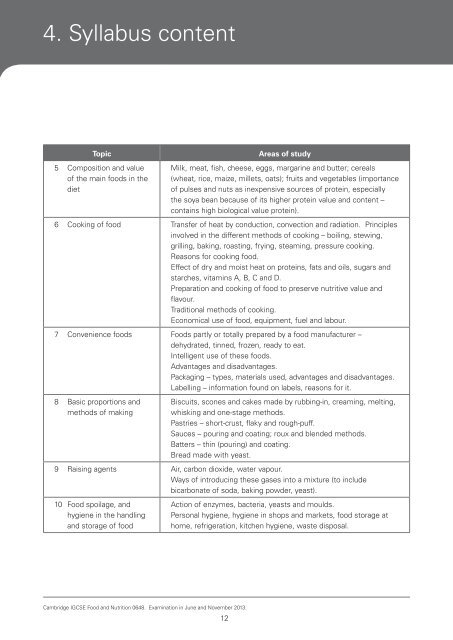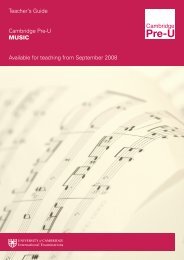2013 Syllabus - Cambridge International Examinations
2013 Syllabus - Cambridge International Examinations
2013 Syllabus - Cambridge International Examinations
You also want an ePaper? Increase the reach of your titles
YUMPU automatically turns print PDFs into web optimized ePapers that Google loves.
4. <strong>Syllabus</strong> contentTopic5 Composition and valueof the main foods in thedietAreas of studyMilk, meat, fish, cheese, eggs, margarine and butter; cereals(wheat, rice, maize, millets, oats); fruits and vegetables (importanceof pulses and nuts as inexpensive sources of protein, especiallythe soya bean because of its higher protein value and content –contains high biological value protein).6 Cooking of food Transfer of heat by conduction, convection and radiation. Principlesinvolved in the different methods of cooking – boiling, stewing,grilling, baking, roasting, frying, steaming, pressure cooking.Reasons for cooking food.Effect of dry and moist heat on proteins, fats and oils, sugars andstarches, vitamins A, B, C and D.Preparation and cooking of food to preserve nutritive value andflavour.Traditional methods of cooking.Economical use of food, equipment, fuel and labour.7 Convenience foods Foods partly or totally prepared by a food manufacturer –dehydrated, tinned, frozen, ready to eat.Intelligent use of these foods.Advantages and disadvantages.Packaging – types, materials used, advantages and disadvantages.Labelling – information found on labels, reasons for it.8 Basic proportions andmethods of makingBiscuits, scones and cakes made by rubbing-in, creaming, melting,whisking and one-stage methods.Pastries – short-crust, flaky and rough-puff.Sauces – pouring and coating; roux and blended methods.Batters – thin (pouring) and coating.Bread made with yeast.9 Raising agents Air, carbon dioxide, water vapour.Ways of introducing these gases into a mixture (to includebicarbonate of soda, baking powder, yeast).10 Food spoilage, andhygiene in the handlingand storage of foodAction of enzymes, bacteria, yeasts and moulds.Personal hygiene, hygiene in shops and markets, food storage athome, refrigeration, kitchen hygiene, waste disposal.<strong>Cambridge</strong> IGCSE Food and Nutrition 0648. Examination in June and November <strong>2013</strong>.12
















